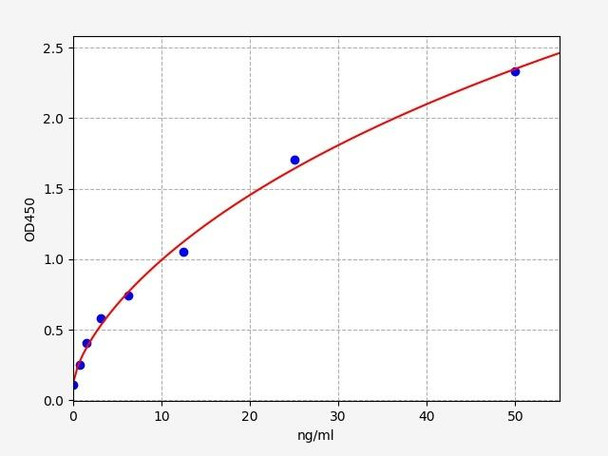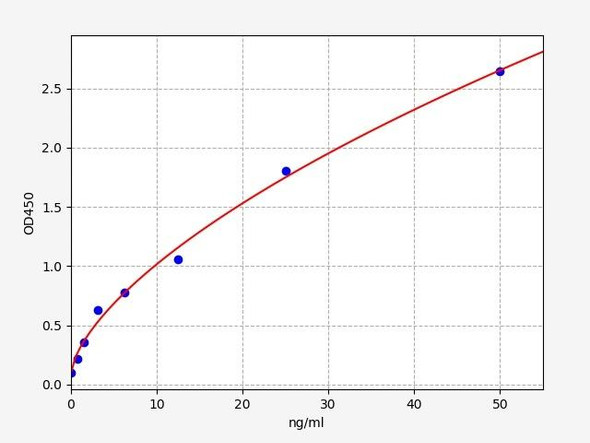Mouse SOD1/Superoxide dismutase 1 ELISA Kit (MOFI00259)
- SKU:
- MOFI00259
- Product Type:
- ELISA Kit
- Size:
- 96 Assays
- Uniprot:
- P08228
- Sensitivity:
- 0.469ng/ml
- Range:
- 0.781-50ng/ml
- ELISA Type:
- Sandwich
- Synonyms:
- SOD1, Cu-Zn SOD, Ipo1, IPOA, SOD, cytosolic, SOD, Soluble, ALS, ALS1, amyotrophic lateral sclerosis 1, adult, Cu, Zn superoxide dismutase, hSod1, indophenoloxidase A, IPOA, SOD, Superoxide dismutase 1, superoxide dismutase 1, soluble, superoxide dism
- Reactivity:
- Mouse
Description
Mouse SOD1/Superoxide dismutase 1 ELISA Kit
The Mouse SOD1 (Superoxide Dismutase 1) ELISA Kit is a powerful tool for the accurate quantification of SOD1 levels in mouse serum, plasma, and tissue lysates. This kit offers exceptional sensitivity and specificity, ensuring precise and reliable results for a variety of research applications.SOD1 is an important enzyme that plays a critical role in antioxidant defense by regulating the levels of superoxide radicals in the body.
Dysregulation of SOD1 has been implicated in a variety of diseases, including neurodegenerative disorders, inflammation, and cancer. This makes the Mouse SOD1 ELISA Kit a valuable asset for studying the role of SOD1 in disease development and progression, as well as for evaluating potential therapeutic interventions.
| Product Name: | Mouse SOD1/Superoxide dismutase 1 ELISA Kit |
| Product Code: | MOFI00259 |
| Size: | 96 Assays |
| Alias: | SOD1, Cu-Zn SOD, Ipo1, IPOA, SOD, cytosolic, SOD, Soluble, ALS, ALS1, amyotrophic lateral sclerosis 1, adult, Cu, Zn superoxide dismutase, hSod1, indophenoloxidase A, IPOA, SOD, Superoxide dismutase 1, superoxide dismutase 1, soluble, superoxide dismutase, cystolic |
| Detection Method: | Sandwich ELISA |
| Application: | This immunoassay kit allows for the in vitro quantitative determination of Mouse SOD1 concentrations in serum plasma and other biological fluids. |
| Sensitivity: | 0.469ng/ml |
| Range: | 0.781-50ng/ml |
| Storage: | 4°C for 6 months |
| Note: | For Research Use Only |
| Recovery: | Matrices listed below were spiked with certain level of Mouse SOD1 and the recovery rates were calculated by comparing the measured value to the expected amount of Mouse SOD1 in samples. | ||||||||||||||||
| |||||||||||||||||
| Linearity: | The linearity of the kit was assayed by testing samples spiked with appropriate concentration of Mouse SOD1 and their serial dilutions. The results were demonstrated by the percentage of calculated concentration to the expected. | ||||||||||||||||
| |||||||||||||||||
| Intra Assay: | CV <8% | ||||||||||||||||
| Inter Assay: | CV <10% |
| Component | Quantity | Storage |
| ELISA Microplate (Dismountable) | 8-12 strips | 4°C for 6 months |
| Lyophilized Standard | 2 | 4°C/-20°C |
| Sample/Standard Dilution Buffer | 20ml | 4°C |
| Biotin-labeled Antibody(Concentrated) | 120ul | 4°C (Protect from light) |
| Antibody Dilution Buffer | 10ml | 4°C |
| HRP-Streptavidin Conjugate(SABC) | 120ul | 4°C (Protect from light) |
| SABC Dilution Buffer | 10ml | 4°C |
| TMB Substrate | 10ml | 4°C (Protect from light) |
| Stop Solution | 10ml | 4°C |
| Wash Buffer(25X) | 30ml | 4°C |
| Plate Sealer | 5 | - |
Other materials and equipment required:
- Microplate reader with 450 nm wavelength filter
- Multichannel Pipette, Pipette, microcentrifuge tubes and disposable pipette tips
- Incubator
- Deionized or distilled water
- Absorbent paper
- Buffer resevoir
| Uniprot | P08228 |
| UniProt Protein Function: | SOD1: Destroys radicals which are normally produced within the cells and which are toxic to biological systems. Homodimer; non-disulfide linked. Homodimerization may take place via the ditryptophan cross-link at Trp-33. The pathogenic variants ALS1 Arg-38, Arg-47, Arg-86 and Ala-94 interact with RNF19A, whereas wild-type protein does not. The pathogenic variants ALS1 Arg-86 and Ala-94 interact with MARCH5, whereas wild-type protein does not. Belongs to the Cu-Zn superoxide dismutase family. |
| UniProt Protein Details: | Protein type:EC 1.15.1.1; Apoptosis; Nuclear receptor co-regulator; Oxidoreductase; Mitochondrial Cellular Component: cell soma; cytoplasm; cytoplasmic vesicle; cytosol; dendrite cytoplasm; extracellular matrix; extracellular region; extracellular space; lysosome; mitochondrial intermembrane space; mitochondrion; myelin sheath; neuron projection; nucleoplasm; nucleus; peroxisome; plasma membrane; protein complex; secretory granule Molecular Function:antioxidant activity; chaperone binding; copper ion binding; enzyme binding; identical protein binding; metal ion binding; oxidoreductase activity; protein binding; protein phosphatase 2B binding; Rac GTPase binding; superoxide dismutase activity; zinc ion binding Biological Process: activation of MAPK activity; aging; anterograde axon cargo transport; auditory receptor cell stereocilium organization and biogenesis; cell aging; cellular iron ion homeostasis; embryo implantation; glutathione metabolic process; heart contraction; hydrogen peroxide biosynthetic process; locomotory behavior; muscle maintenance; myelin maintenance in the peripheral nervous system; myeloid cell homeostasis; negative regulation of apoptosis; negative regulation of cholesterol biosynthetic process; negative regulation of neuron apoptosis; neurofilament cytoskeleton organization and biogenesis; ovarian follicle development; positive regulation of catalytic activity; positive regulation of cytokine production; positive regulation of superoxide release; regulation of blood pressure; regulation of GTPase activity; regulation of mitochondrial membrane potential; regulation of multicellular organism growth; regulation of protein kinase activity; relaxation of vascular smooth muscle; removal of superoxide radicals; response to axon injury; response to copper ion; response to drug; response to ethanol; response to heat; response to hydrogen peroxide; response to nutrient levels; response to organic substance; response to oxidative stress; response to reactive oxygen species; response to superoxide; retinal homeostasis; retrograde axon cargo transport; sensory perception of sound; spermatogenesis; superoxide metabolic process; superoxide release; transmission of nerve impulse |
| UniProt Code: | P08228 |
| NCBI GenInfo Identifier: | 45597447 |
| NCBI Gene ID: | 20655 |
| NCBI Accession: | NP_035564.1 |
| UniProt Related Accession: | P08228 |
| Molecular Weight: | 17.8 kDa |
| NCBI Full Name: | superoxide dismutase |
| NCBI Synonym Full Names: | superoxide dismutase 1, soluble |
| NCBI Official Symbol: | Sod1 |
| NCBI Official Synonym Symbols: | Ipo1; SODC; Ipo-1; Sod-1; CuZnSOD; Cu/Zn-SOD; B430204E11Rik |
| NCBI Protein Information: | superoxide dismutase [Cu-Zn] |
| UniProt Protein Name: | Superoxide dismutase [Cu-Zn] |
| Protein Family: | Superoxide dismutase |
| UniProt Gene Name: | Sod1 |
| UniProt Entry Name: | SODC_MOUSE |
*Note: Protocols are specific to each batch/lot. For the correct instructions please follow the protocol included in your kit.
| Step | Procedure |
| 1. | Set standard, test sample and control (zero) wells on the pre-coated plate respectively, and then, record their positions. It is recommended to measure each standard and sample in duplicate. Wash plate 2 times before adding standard, sample and control (zero) wells! |
| 2. | Aliquot 0.1ml standard solutions into the standard wells. |
| 3. | Add 0.1 ml of Sample / Standard dilution buffer into the control (zero) well. |
| 4. | Add 0.1 ml of properly diluted sample (Human serum, plasma, tissue homogenates and other biological fluids.) into test sample wells. |
| 5. | Seal the plate with a cover and incubate at 37 °C for 90 min. |
| 6. | Remove the cover and discard the plate content, clap the plate on the absorbent filter papers or other absorbent material. Do NOT let the wells completely dry at any time. Wash plate X2. |
| 7. | Add 0.1 ml of Biotin- detection antibody working solution into the above wells (standard, test sample & zero wells). Add the solution at the bottom of each well without touching the side wall. |
| 8. | Seal the plate with a cover and incubate at 37°C for 60 min. |
| 9. | Remove the cover, and wash plate 3 times with Wash buffer. Let wash buffer rest in wells for 1 min between each wash. |
| 10. | Add 0.1 ml of SABC working solution into each well, cover the plate and incubate at 37°C for 30 min. |
| 11. | Remove the cover and wash plate 5 times with Wash buffer, and each time let the wash buffer stay in the wells for 1-2 min. |
| 12. | Add 90 µL of TMB substrate into each well, cover the plate and incubate at 37°C in dark within 10-20 min. (Note: This incubation time is for reference use only, the optimal time should be determined by end user.) And the shades of blue can be seen in the first 3-4 wells (with most concentrated standard solutions), the other wells show no obvious color. |
| 13. | Add 50 µL of Stop solution into each well and mix thoroughly. The color changes into yellow immediately. |
| 14. | Read the O.D. absorbance at 450 nm in a microplate reader immediately after adding the stop solution. |
When carrying out an ELISA assay it is important to prepare your samples in order to achieve the best possible results. Below we have a list of procedures for the preparation of samples for different sample types.
| Sample Type | Protocol |
| Serum: | If using serum separator tubes, allow samples to clot for 30 minutes at room temperature. Centrifuge for 10 minutes at 1,000x g. Collect the serum fraction and assay promptly or aliquot and store the samples at -80°C. Avoid multiple freeze-thaw cycles. If serum separator tubes are not being used, allow samples to clot overnight at 2-8°C. Centrifuge for 10 minutes at 1,000x g. Remove serum and assay promptly or aliquot and store the samples at -80°C. Avoid multiple freeze-thaw cycles. |
| Plasma: | Collect plasma using EDTA or heparin as an anticoagulant. Centrifuge samples at 4°C for 15 mins at 1000 - g within 30 mins of collection. Collect the plasma fraction and assay promptly or aliquot and store the samples at -80°C. Avoid multiple freeze-thaw cycles. Note: Over haemolysed samples are not suitable for use with this kit. |
| Urine & Cerebrospinal Fluid: | Collect the urine (mid-stream) in a sterile container, centrifuge for 20 mins at 2000-3000 rpm. Remove supernatant and assay immediately. If any precipitation is detected, repeat the centrifugation step. A similar protocol can be used for cerebrospinal fluid. |
| Cell culture supernatant: | Collect the cell culture media by pipette, followed by centrifugation at 4°C for 20 mins at 1500 rpm. Collect the clear supernatant and assay immediately. |
| Cell lysates: | Solubilize cells in lysis buffer and allow to sit on ice for 30 minutes. Centrifuge tubes at 14,000 x g for 5 minutes to remove insoluble material. Aliquot the supernatant into a new tube and discard the remaining whole cell extract. Quantify total protein concentration using a total protein assay. Assay immediately or aliquot and store at ≤ -20°C. |
| Tissue homogenates: | The preparation of tissue homogenates will vary depending upon tissue type. Rinse tissue with 1X PBS to remove excess blood & homogenize in 20ml of 1X PBS (including protease inhibitors) and store overnight at ≤ -20°C. Two freeze-thaw cycles are required to break the cell membranes. To further disrupt the cell membranes you can sonicate the samples. Centrifuge homogenates for 5 mins at 5000xg. Remove the supernatant and assay immediately or aliquot and store at -20°C or -80°C. |
| Tissue lysates: | Rinse tissue with PBS, cut into 1-2 mm pieces, and homogenize with a tissue homogenizer in PBS. Add an equal volume of RIPA buffer containing protease inhibitors and lyse tissues at room temperature for 30 minutes with gentle agitation. Centrifuge to remove debris. Quantify total protein concentration using a total protein assay. Assay immediately or aliquot and store at ≤ -20 °C. |
| Breast Milk: | Collect milk samples and centrifuge at 10,000 x g for 60 min at 4°C. Aliquot the supernatant and assay. For long term use, store samples at -80°C. Minimize freeze/thaw cycles. |
| Antibodies | ELISA |
| Mouse Superoxide dismutase [Cu-Zn] (Sod1) ELISA Kit |




![Mouse Superoxide dismutase [Cu-Zn] (Sod1) ELISA Kit (MOEB0480) Mouse Superoxide dismutase [Cu-Zn] (Sod1) ELISA Kit (MOEB0480)](https://cdn11.bigcommerce.com/s-h68l9z2lnx/images/stencil/590x590/products/37072/661867/mouse-superoxide-dismutase-cu-zn-sod1-elisa-kit-moeb0480__32766.1744341751.jpg?c=2)

